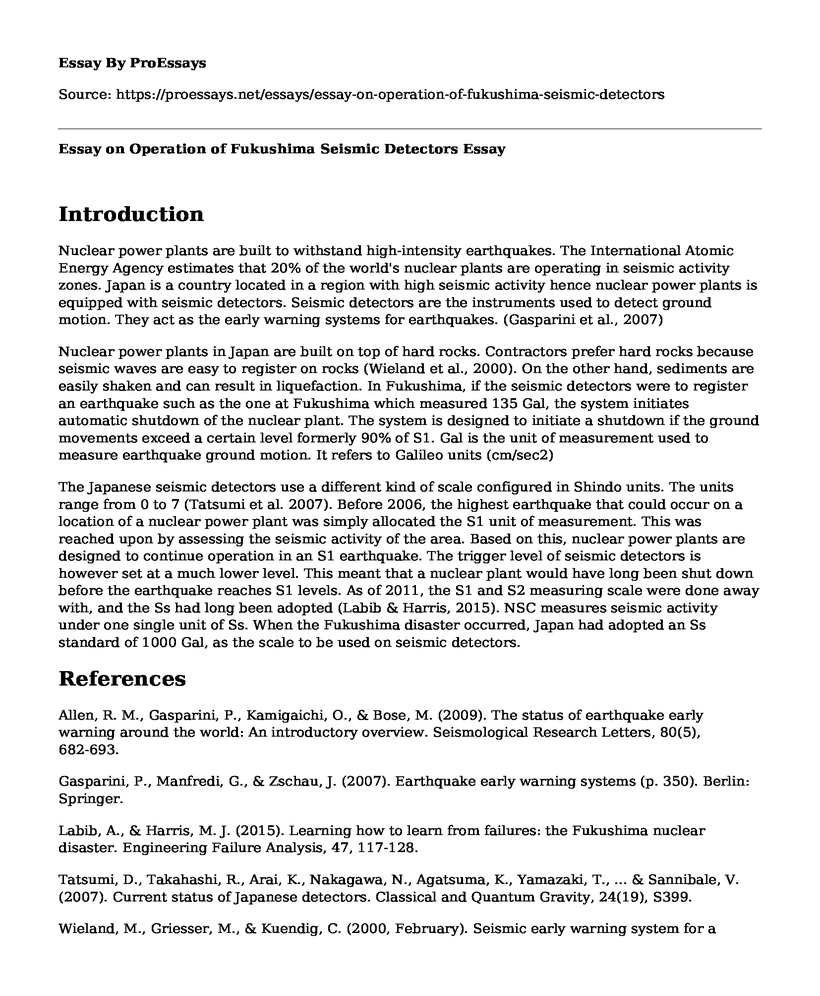Introduction
Nuclear power plants are built to withstand high-intensity earthquakes. The International Atomic Energy Agency estimates that 20% of the world's nuclear plants are operating in seismic activity zones. Japan is a country located in a region with high seismic activity hence nuclear power plants is equipped with seismic detectors. Seismic detectors are the instruments used to detect ground motion. They act as the early warning systems for earthquakes. (Gasparini et al., 2007)
Nuclear power plants in Japan are built on top of hard rocks. Contractors prefer hard rocks because seismic waves are easy to register on rocks (Wieland et al., 2000). On the other hand, sediments are easily shaken and can result in liquefaction. In Fukushima, if the seismic detectors were to register an earthquake such as the one at Fukushima which measured 135 Gal, the system initiates automatic shutdown of the nuclear plant. The system is designed to initiate a shutdown if the ground movements exceed a certain level formerly 90% of S1. Gal is the unit of measurement used to measure earthquake ground motion. It refers to Galileo units (cm/sec2)
The Japanese seismic detectors use a different kind of scale configured in Shindo units. The units range from 0 to 7 (Tatsumi et al. 2007). Before 2006, the highest earthquake that could occur on a location of a nuclear power plant was simply allocated the S1 unit of measurement. This was reached upon by assessing the seismic activity of the area. Based on this, nuclear power plants are designed to continue operation in an S1 earthquake. The trigger level of seismic detectors is however set at a much lower level. This meant that a nuclear plant would have long been shut down before the earthquake reaches S1 levels. As of 2011, the S1 and S2 measuring scale were done away with, and the Ss had long been adopted (Labib & Harris, 2015). NSC measures seismic activity under one single unit of Ss. When the Fukushima disaster occurred, Japan had adopted an Ss standard of 1000 Gal, as the scale to be used on seismic detectors.
References
Allen, R. M., Gasparini, P., Kamigaichi, O., & Bose, M. (2009). The status of earthquake early warning around the world: An introductory overview. Seismological Research Letters, 80(5), 682-693.
Gasparini, P., Manfredi, G., & Zschau, J. (2007). Earthquake early warning systems (p. 350). Berlin: Springer.
Labib, A., & Harris, M. J. (2015). Learning how to learn from failures: the Fukushima nuclear disaster. Engineering Failure Analysis, 47, 117-128.
Tatsumi, D., Takahashi, R., Arai, K., Nakagawa, N., Agatsuma, K., Yamazaki, T., ... & Sannibale, V. (2007). Current status of Japanese detectors. Classical and Quantum Gravity, 24(19), S399.
Wieland, M., Griesser, M., & Kuendig, C. (2000, February). Seismic early warning system for a nuclear power plant. In Proceedings of the 12th world conference on earthquake engineering (WCEE 2000).
Cite this page
Essay on Operation of Fukushima Seismic Detectors. (2022, Apr 04). Retrieved from https://proessays.net/essays/essay-on-operation-of-fukushima-seismic-detectors
If you are the original author of this essay and no longer wish to have it published on the ProEssays website, please click below to request its removal:
- Research Paper on Noise Pollution: Reducing its Negative Impacts
- How Climate Changes, Global Warming, and Pollution Negatively Affect Earth?
- Essay Sample on Global Warming as an Environmental Problem
- Park Rangers: Protecting Nature & Preserving Safety - Essay Sample
- Essay Example on Unleashing the Potential of Solar Energy: A History of Innovation
- Essay Example on Saving Our Environment: Challenges and Solutions
- Free Report on Air Pollution Control Bill 2020: Overview of the US Federal Law







